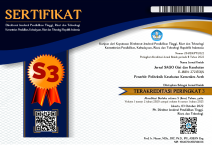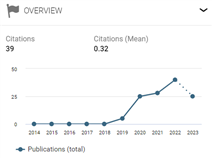Pengaruh konsentrasi ekstrak daun pare (momordica charantia l.) terhadap kematian larva aedes aegypti
DOI: 10.30867/gikes.v6i2.2320Abstract
Background: Dengue Hemorrhagic Fever (DHF) is a health problem in Indonesia, transmitted by the Aedes aegypti mosquito. Bitter melon leaves contain active compounds such as saponins, alkaloids, and flavonoids belived to be effective as larvacides and are expected to serve as a more environmentally friendly alternative for mosquito control in preventing the spread of DHF.
Objective: To determine the potential of natural biolarvacide from bitter melon leaf extract (Momordica charantia L.) against Aedes aegypti larvae.
Methods: An experimental study was conducted at the Public Health Laboratory of Tanah Bumbu in July 2024. This experimental research used 375 Aedes aegypti larvae with five treatments and three repetitions, observing the number of larvae that died after 24 hours. The data were analyzed using the Shapiro-Wilk test, Levene's test, Kruskal-Wallis test, Mann-Whitney test, and probit analysis.
Results: Bitter melon leaf extract at concentrations of 0,3% and 0,6% did not cause larval death, so it was not effective in inhibiting the growth of Aedes aegypti. While at concentrations of 0,9% showed a significant effect in inhibiting larval growth. The results of the Kruskal-Wallis test on the death of larvae treated with bitter melon leaf extract obtained a significance value of 0,008 (p <0,05). The results of the Mann-Whitney test showed that there was a significant difference between the concentration of 0,9% bitter melon leaf extract and the positive control abate, as well as between the negative control aquadest and the concentration of 0,9% bitter melon leaf extract. The results of the probit analysis test obtained an LC50 value of 1,202%.
Conclusion: The 0.9% concentration of bitter melon leaf extract can inhibit the growth of Aedes aegypti larvae. However, it is not yet suitable as an alternative bio-larvicide.
Keywords
Full Text:
PDFReferences
Apriadi Siregar, P., Sapriani Harahap, R., Raihan Pratama, M., & Adnin Purba, F. (2023). Analisis pengetahuan masyarakat sekitar tentang penyakit demam berdarah dengue (DBD). JK: Jurnal Kesehatan, 1(1), 25–35.
Aziz, Y. S., Ardyanto, M., & Ikhza, M. (2019). Standarisasi parameter non spesifik simplisia rimpang kunyit (curcumae domestica rizhoma) dan temulawak (curcuma xanthorrhiza roxb.) di Kabupaten Ponorogo. Jurnal Delima Harapan, 6(2), 89–94.
Dharma, W. S. T., Astiani, R., & Rukmana, A. L. (2017). Pemantauan terapi obat pada pasien dengue hemmoragic fever (dhf) di Ruang Perawatan Flamboyan Rumah Sakit Omni Pulomas. Social Clinical Pharmacy Indonesia Journal, 2(1), 2502–8413.
Dinas Kesehatan Kalteng. (2023). Laporan Penderita DBD 2023.
Handayani, N., Santoso, L., Martini, & Purwantisari, S. (2016). Status resistensi larva aedes aegypti terhadap temephos di Wilayah Perimeter dan Buffer Pelabuhan Tanjung Emas Kota Semarang. Jurnal Kesehatan Masyarakat, 4(1), 2356–3346. http://ejournal-s1.undip.ac.id/index.php/jkm
Hataningtyas, N., Wilapangga, A., Royani, S., Bina, S., & Purwokerto, C. H. (2024). Skrining fitokimia ekstrak etanol 96% bunga telang (clitoria ternatea l.) dan uji kemampuan sebagai antibakteri. Journal Of Pharmacy, 1(2), 132.
Jing, Q., & Wang, M. (2019). Dengue epidemiology. Journal of Global Health, 3(2). https://doi.org/10.1016/j.glohj.2019.06.002
Mawuntu, M. S. (2016). Efektivitas ekstrak daun sirsak dan daun pepaya dalam pengendalian plutella xylostella l. (lepidoptera; yponomeutidae) pada tanaman kubis di Kota Tomohon. Jurnal Ilmiah Sains, 16(1).
Noviyanty, A., & Anggriani Salingkat, C. (2019). Pengaruh rasio pelarut terhadap ekstraksi dari kulit buah naga merah (hylocereus polyrhizus). Kovalen, 5(3), 280–289.
Nugraheni, E., Rizqoh, D., & Sundari, M. (2023). Manifestasi klinis demam berdarah dengue (DBD). Jurnal Kedokteran Dan Kesehatan: Publikasi Ilmiah Fakultas Kedokteran Universitas Sriwijaya, 10(3), 267–274. https://doi.org/10.32539/jkk.v10i3.21425
Rostina, K. P. K. A. A., Kasim, K. P., & Awaliy, A. (2023). Uji efektivitas sari daun peria (momordica charantia) terhadap mortalitas jentik aedes aegypti. Jurnal Sulolipu, 23(1).
Suhaimi, & Kartikasari, D. (2018). Uji aktivitas larvasida granul ekstrak batang seledri (avium graveolens) pada larva instar 3 aedes aegypti. Jurnal Insan Farmasi Indonesia, 1(2), 260–267.
Suling, L., Augustina, I., & Fatmaria. (2020). Uji daya bunuh ekstrak etanol 70% kelakai (stenochlaena palustris (burm. f.) bedd) terhadap larva instar iii aedes aegypti. Herb-Medicine Journal, 3(1).
Wandira, A., Cindiansya, Rosmayati, J., Anandari, R. F., Naurah, S. A., & Fikayuniar, L. (2023). Menganalisis pengujian kadar air dari berbagai simplisia bahan alam menggunakan metode gravimetri. Jurnal Ilmiah Wahana Pendidikan, 190–193.
World Health Organization. (2024). Dengue and severe dengue.
Refbacks
- There are currently no refbacks.














